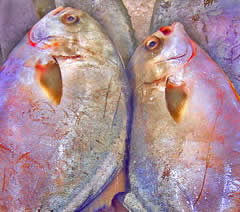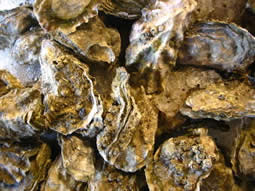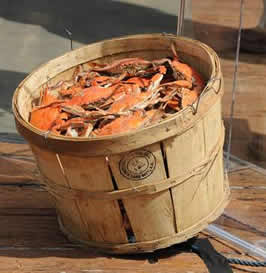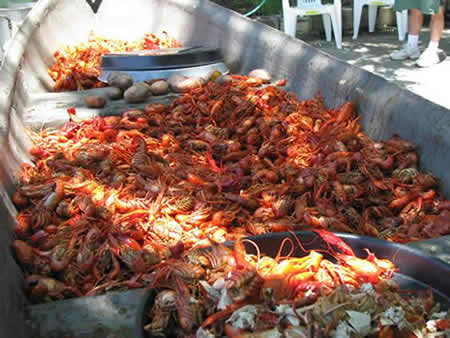Keeping Seafood Fresh
Storing Fresh Fish

- Get a colander or another type of container that has holes in the bottom. You need this container to be able to drain off water.
- Then fill this with crushed ice.
- Put the fish on the crushed ice. You don't want the fish to be resting in water - only in contact with the ice.
- If it's a whole fish - place it belly down in the ice – oriented the same way it would swim.
- Put the container inside something larger that the water can drain off into.
- Cover the containers as tightly as you can.
- Place in the coldest part of your refrigerator – usually at the bottom in the back.
-
Method 2 – Wrap The Fish
- Wrap the fish in either wax paper or foil.
- Seal the ends tightly.
- Place the wrapped fish in an airtight covered container.
- Put the container in the coldest part of your refrigerator.
Storing Fresh Clams, Oysters, or Mussels
Bivavles should be kept alive until you're ready to cook or serve them. Be sure to keep them cool on the ride home from the store. Don't let them sit around in a hot car while you do more shopping!
- Put them in an open container in your refrigerator.
- Cover them with a clean moist towel so that they won't dry out.
- Your frig should be between 35-40° F.
- Do NOT store them in plastic bags, or closed containers, or in a bucket of water.
- Before you go to cook or serve them, check for any open shells. If one is open you can simply tap on the shell or squeeze it shut. If it opens back up, then discard it and do not eat it.
Storing Shucked Bivalves

- How to store shucked clams and mussels
- Store them with their liquid in an airtight container in the refrigerator.
- How to store shucked oysters
- They can be stored in an airtight container or covered bowl in your refrigerator.
- Keep them in the coldest part of your refrigerator.
- How to store shucked scallops
- They are best stored in a sealed container.
- Put that container in a bowl of ice.
- Keep them in the coldest part of your refrigerator.
Storing Fresh Crab
- How to store live blue crabs
- They need to be kept alive, cool and moist and must be able to breath.
- A cardboard box or paper bag works well.
- They need to be at about 50° F.
- Do not store them in a bucket of water -they will suffocate.
- Do not store them directly on ice -they will die.

- How to store crab legs or cooked crab
- Store in airtight containers OR
- Wrap with heavy-duty aluminum foil.
- Put them in the refrigerator.
- How to store fresh crab meat
- It should be stored on ice in your refrigerator.
Storing Shrimp
- How to store fresh shrimp
- To keep it lasting longest, store the shrimp on crushed ice.
- Either allow the water to drain through a colander, or drain it yourself a couple times a day.
- Put the container in the coldest part of your refrigerator.
- How to store cooked shrimp
- Store in a sealed bag or container in your refrigerator.
Storing Live Lobsters
- How to store live lobster
- They need to be kept alive until you cook them.
- Keep them in an open container, such as a cardboard box, in your refrigerator or a cooler.
- Put seaweed or damp newspaper in the box on top of them.
- Keep them moist -but not wet.
- If they're in a cooler, do not close the lid -they need to breathe.
- Do not store them on ice -they will die.
- Do not store them in water -they will die.
Storing Live Crawfish / Crayfish
- How to store live crawfish
- They need to be kept alive until you cook them.
- Keep them cool and moist -between 40 - 50° F.
- Keep them in an open container, such as a cardboard box, in your refrigerator or a cooler.
- You can put crushed ice around the container to help keep them cool.
- Put seaweed, wet burlap sacks or damp newspaper in the box on top of them.
- Do not store them in water -they will die.
- Don't eat the ones that have straight tails after being cooked. It means they were dead before you cooked them. Not eveyone adheres to this rule though. If the meat falls apart after you cook it, then you definitely do not want to eat that one.

